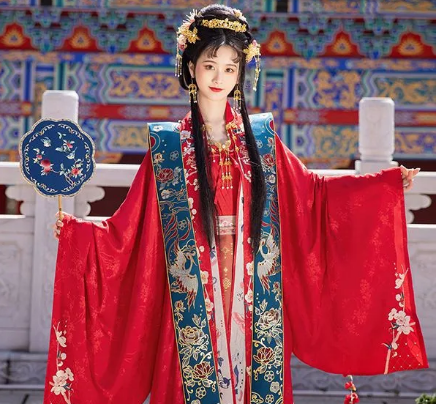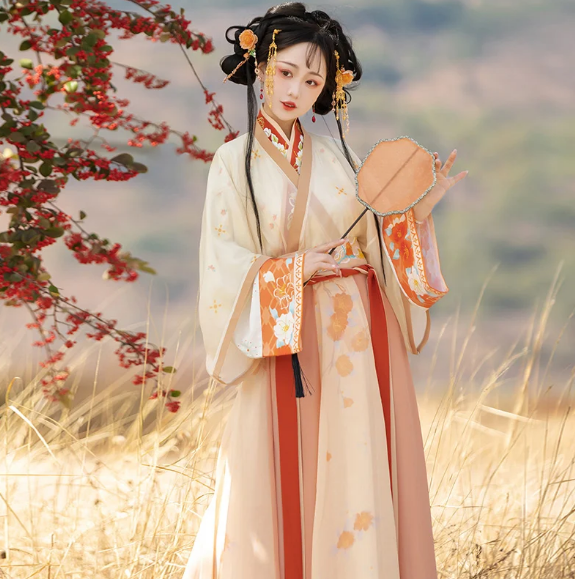Hairpins, jewelry, belts, and sashes enhance Hanfu outfits, reflecting tradition and elegance.
Historical Overview of Hanfu Accessories
Traditional Accessories in Ancient Dynasties
Hanfu, the quintessential attire of the Han Chinese, traces its origins back over 4000 years, weaving a rich tapestry of cultural significance. In these ancient times, accessories were not mere ornaments but symbols of status and spiritual beliefs. The Shang Dynasty (c. 1600 – c. 1046 BC) revered jade, using it extensively in accessories, as it symbolized purity and a mystical connection to the heavens. Moving into the Zhou Dynasty (1046–256 BC), the evolution was evident in the ornate hairpins and elaborate belts that graced the Hanfu. These pieces did more than just hold the clothing together; they were artistic statements, reflective of the wearer’s social standing.
The Han Dynasty (202 BC – 220 AD) marked a significant shift in the use of accessories. Here, gold and silver began to dominate the accessory scene, signaling wealth and nobility. Hair ornaments grew increasingly intricate, often bedecked with pearls and gemstones. This era also introduced the bian fang and pei, square-shaped and waist pendants respectively, both symbolizing affluence and rank.

Evolution of Hanfu Accessories Over Time
With the Tang Dynasty (618–907 AD), there was a burst of color and diversity in accessory styles, thanks in part to the cultural exchanges along the Silk Road. This era is famed for its flamboyant fashion, where women wore large, vibrant hairpins and headdresses. The Tang era also popularized the buyao, a hairpin with dangling ornaments that added a touch of grace to the wearer’s movements.
The refinement of Hanfu accessories reached its zenith during the Song Dynasty (960–1279 AD), where simplicity and elegance became the prevailing trends. Accessories during this period were often smaller, made of ivory, silver, or gold, and carried motifs inspired by nature. The Ming (1368–1644 AD) and Qing (1644–1912 AD) dynasties furthered this trend, each adding their unique touch to the designs and styles of Hanfu accessories, reflecting the evolving tastes and influences of their times.
Today’s resurgence in Hanfu fashion has rekindled interest in these traditional accessories. Modern designers draw inspiration from historical styles, merging traditional craftsmanship with contemporary aesthetics. This blend of old and new creates accessories that are both a nod to their historical roots and a match for today’s fashion sensibilities.
Throughout history, Hanfu accessories have transcended their role as mere adornments to become symbols of China’s rich cultural legacy and evolving artistic expression. They offer a window into the historical and cultural transformations of the Chinese people. For a deeper understanding of the history and cultural significance of Hanfu and its accessories, the Hanfu and Chinese clothing Wikipedia pages are rich resources.
Types of Accessories for Hanfu
Hair Ornaments
Hair ornaments in the world of Hanfu fashion are not mere decorations; they embody deep cultural meanings and social status. The most common types, including hairpins, combs, and hair sticks, each tell a story of their own. The zàn, a type of hairpin, typically made of metal or bone and often adorned with pearls or jade, signifies nobility and elegance. The ji, a hair comb, varies in material and design, reflecting the social class of its wearer. In significant events like weddings, women often adorn their hair with these ornaments, believed to bring good luck and ward off evil spirits. These ornaments, particularly in weddings, usually feature red and gold, symbolizing happiness and prosperity. For a detailed exploration of these ornaments, the Chinese hairpin Wikipedia page offers extensive information.
Jewelry
In the array of Hanfu accessories, jewelry holds a special place, with necklaces, bracelets, and earrings being the most prevalent. Necklaces in Hanfu attire often feature multiple layers, crafted with beads or precious stones, showcasing the wearer’s status and elegance. Bracelets, typically jade, gold, or silver, and sometimes adorned with bells, create a subtle jingle with movement. Earrings, although not universally worn due to traditional beliefs, were popular among certain social classes and often took the form of delicate gold or silver hoops. Each piece of jewelry, from jade bracelets believed to promote health to intricately designed earrings, has its unique significance and history, as detailed on the Chinese jewelry Wikipedia page.
Belts and Sashes
Sashes and belts are more than functional elements in Hanfu; they are expressions of taste and status. Belts, known as dai, are essential for securing the robes, often featuring ornamental buckles and pendants. The variety ranges from simple cloth to silk adorned with intricate embroidery. Sashes, or yao dai, broader and longer than belts, are tied in various symbolic knots for different occasions. These accessories transform the Hanfu, adding layers of elegance and sophistication. The art of selecting and tying these sashes reflects personal style and tradition. For more insights into the diversity and significance of these accessories, the Hanfu Wikipedia page provides a wealth of information.
Through each type of accessory, from hair ornaments to jewelry, and belts to sashes, the rich tapestry of Hanfu fashion unfolds, showcasing the depth and elegance of traditional Chinese culture. These accessories are not just additions; they are integral elements that bring the Hanfu to life, each with its unique story and cultural importance.
Matching Accessories with Different Hanfu Styles
Accessories for Formal Hanfu
When it comes to formal Hanfu, such as court dresses and ceremonial attire, the choice of accessories is pivotal to completing the ensemble. For court dresses, intricate and luxurious accessories are the norm. Women often opt for elaborate hair ornaments like the fengguan – a type of phoenix crown, often decorated with pearls, jade, and kingfisher feathers. This headpiece, a symbol of nobility and often seen in traditional Chinese weddings, adds a regal touch to the outfit. Men’s formal attire typically pairs with jingling, a type of hat ornamented with beads or jade that hangs from the hat and gently sways with movement, lending an air of dignity and grace.
Ceremonial Hanfu, worn during important festivals and religious ceremonies, often requires specific accessories that carry symbolic meanings. For example, during the Lunar New Year celebrations, red accessories, believed to bring good luck and ward off evil spirits, are popular choices. Jade pendants and bracelets are common, symbolizing purity and moral integrity. For more in-depth information, the Hanfu Wikipedia page provides a comprehensive look at these traditional garments and their accompanying accessories.
Casual Hanfu Accessories
The accessories for casual Hanfu, worn in everyday settings, lean towards simplicity and practicality while still maintaining elegance. Simple hairpins made of wood or bamboo, and fabric belts or sashes, are commonly paired with casual Hanfu. These accessories complement the relaxed nature of the attire without overpowering it. The hairpins are often minimalistic, sometimes with a single decorative element like a small flower or bead, adding a touch of sophistication without being overly ornate.
For casual wear, jewelry is typically understated. Small earrings, thin bracelets, and delicate necklaces are preferred, often made of silver or semi-precious stones. These pieces add a subtle elegance to the overall look, enhancing the wearer’s natural beauty without drawing too much attention. The focus on simplicity and natural beauty is a key element of casual Hanfu styling, as explored on the Chinese clothing Wikipedia page.
In both formal and casual settings, the art of matching accessories with Hanfu is about finding the right balance between the outfit and the adornments, ensuring that each piece complements the other to create a harmonious and aesthetically pleasing ensemble. The choice of accessories not only enhances the beauty of the Hanfu but also reflects the wearer’s understanding and appreciation of traditional Chinese culture and fashion.

Cultural Significance of Hanfu Accessories
Symbolism in Hanfu Accessories
Hanfu accessories are steeped in symbolism, reflecting the rich cultural heritage of China. Each accessory, from hairpins to belts, carries its unique symbolism and cultural significance. For instance, jade accessories, highly valued in Chinese culture, symbolize purity and moral integrity. In ancient times, wearing jade was believed to protect the wearer from evil and bring good fortune. The fengguan, or phoenix crown, worn by brides and noblewomen, symbolizes auspiciousness and high status. This crown, often adorned with phoenixes and dragons, represents the perfect union of yin and yang, an essential concept in Taoist philosophy.
Hairpins, beyond their practical use, often bear symbols of nature like flowers or birds, each with its own meaning. A hairpin with a plum blossom, for instance, represents resilience and perseverance, as plum blossoms bloom in harsh winter conditions. For a deeper understanding of these symbols, the Chinese symbolism Wikipedia page provides a rich resource on the subject.
The Role of Accessories in Traditional Hanfu Etiquette
In traditional Hanfu etiquette, accessories play a vital role in communicating social status, age, and marital status. The intricacy and material of the accessories often indicate the wearer’s social ranking. Nobility and royalty would wear accessories made of precious metals and stones, while commoners would have simpler adornments made of wood or bone. The number and style of hairpins worn by a woman could indicate her marital status – unmarried girls typically wore one hairpin, while married women wore more elaborate hairpieces.
Belts and sashes in Hanfu also have their significance. The way a sash is tied and the pattern on the belt can signify the occasion or the wearer’s mood. For example, a loosely tied sash might indicate a relaxed or casual occasion, while a tightly knotted belt would be for formal events. The Hanfu Wikipedia page delves deeper into the etiquette and symbolism associated with traditional Chinese garments.
The cultural significance of Hanfu accessories is profound, as they do more than just complete an outfit. They are a form of non-verbal communication, conveying messages about the wearer’s identity, status, and beliefs. Understanding these subtleties adds depth to the appreciation of Hanfu and its accessories, revealing the rich tapestry of Chinese culture and history.